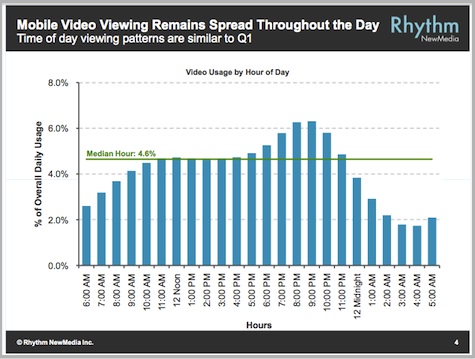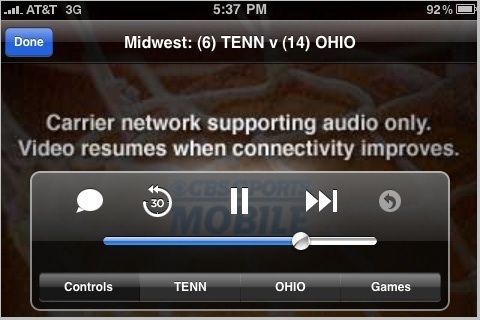-
As the iPhone Turns 10, Here Are 7 Reasons Mobile Video Is At A Tipping Point
It was 10 years ago today that Steve Jobs unveiled the iPhone. Looking back, it’s hard to believe that even Jobs could have imagined how profound and far-reaching the iPhone’s impact would be. One short decade later, there is arguably not a single Internet application that hasn’t been impacted by mobile. Meanwhile, many new applications have been created solely as a result of the mobile phenomenon.
Mobile video is certainly one application that was essentially created by the iPhone and subsequent smartphones. Watching video on smartphones is now a completely mainstream behavior, which countless millions of people engage with regularly. But despite mobile video’s already impressive growth, there are at least 7 reasons mobile video is now at a tipping point, with the biggest growth still ahead:Categories: Mobile Video
Topics: Apple, AT&T, Comcast, Facebook, iPhone, T-Mobile, Verizon
-
iPhone 6 is Poised to Drive Mobile Video Still Higher
Mobile video is on a roll, with multiple recent data sources indicating an explosion in usage. Now, with the introduction of the iPhone 6, mobile video's best days are likely still ahead. That means content providers must further refine their content development and distribution strategies for a more mobile-centric world.
This morning Apple said that it has sold over 10 million of the two new iPhones in their first 3 days of availability. No doubt this is the first of many record-breaking milestones for the new smartphones. Mobile video will benefit from both the iPhone 6 and 6 Plus as they are extremely video-friendly, with their larger, higher resolution "Retina HD" screens, faster processors and longer battery lives (they're also great video capture devices, but I'll save that angle for another day).Categories: Mobile Video
-
VideoNuze-TDG Report Podcast #147 - Internet to Kill TV?; iPhone 5 and Mobile Video
Colin Dixon, senior partner at The Diffusion Group and I are back for the 147th edition of the VideoNuze-TDG Report podcast. This week we start with Colin sharing his observations on a session that he attended at IBC in Amsterdam last week, "The Great Connected Television Debate: Will the Internet be the End of Television As We Know It." Colin comes down on the side that "yes, it will," and articulates how the conventional definition of television is melting away as behaviors shift and technology further develops.
Speaking of technology, we then discuss the impact of the iPhone 5 on mobile video. I argued yesterday that it will have a big impact, and although Colin believes iPhone 5 is a bit of a yawn, he agrees that it will push mobile video adoption and usage forward.
Listen in to learn more!
Click here to listen to the podcast (21 minutes, 17 seconds)
Click here for previous podcasts
The VideoNuze-TDG Report podcast is available in iTunes...subscribe today!Categories: Devices, Mobile Video, Podcasts
Topics: Apple, IBC, iPhone, Podcast
-
iPhone 5 Should Have a Big Impact On Mobile Video
No doubt you've already read a lot about the new iPhone 5. It's hard to add anything material to the conversation, except that, at the risk of stating the obvious, it sure feels like it's going to have a significant impact on mobile video. The combination of a bigger, higher resolution display, support for faster, 4G LTE wireless networks, longer battery life, a more powerful processor, 720p HD FaceTime and better video recording, and importantly a new and improved YouTube app are key ingredients for fueling a better mobile video experience, and therefore more use.
And with 45-50 million units projected to be shipped in Q4 alone, iPhone 5's impact on mobile video could be felt very quickly and broadly. It's going to be fun to watch (and yes, if you were curious, I'm planning to drop my Droid and get the iPhone 5).Categories: Mobile Video
-
YouTube's New iPhone App is Live, With Ads
YouTube's new app for the iPhone and iPod touch is now live and available for download. The news comes a month after Apple said it wouldn't include its own YouTube app in the next version of iOS, thereby paving the way for YouTube to build and deploy its own.
In a blog post, YouTube described some of the key benefits of the new app: tens of thousands more videos, a channel guide with swipe navigation, enhanced search tools and the ability to share videos via Facebook, Google+, Twitter, email and text. I'm not an iPhone user (though plan to be shortly), so I haven't been able to test the new app. However, the description suggests a lot of commonality with the Android app I'm accustomed to, though the UI does seem a bit different.Categories: Aggregators, Mobile Video
Topics: Apple, iPhone, YouTube
-
What's Up With Verizon Wireless Throttling Its Heaviest Users?
Verizon's well-orchestrated buzz-building campaign for its iPhone launch yesterday hit a speed bump as stories began to circulate that even though it was promoting an unlimited data plan as a differentiator, it would actually throttle its heaviest users. Verizon's official policy is that "if you use an extraordinary amount of data and fall within the top 5% of Verizon Wireless data users we may reduce your data throughput speeds periodically for the remainder of your then current and immediately following billing cycle to ensure high-quality network performance for other users at locations and times of peak demand."
throttle its heaviest users. Verizon's official policy is that "if you use an extraordinary amount of data and fall within the top 5% of Verizon Wireless data users we may reduce your data throughput speeds periodically for the remainder of your then current and immediately following billing cycle to ensure high-quality network performance for other users at locations and times of peak demand."
Topics: iPhone, Verizon Wireless
-
CES Takeaway #3: Mobility is Video's Next Frontier
(Note: Each day this week I'm writing about one key takeaway from last week's CES 2011. Also, next Wednesday, January 19th, The Diffusion Group's Colin Dixon and I will be hosting a complimentary webinar, "Demystifying CES 2011," in which we'll discuss key CES highlights and answer participants' questions.)
One of the clear trends that emerges from the video-related product announcements at CES 2011, and in the months leading up to it, is that mobility is video's next frontier.
Just as online video adoption grew out of massive online Internet use, mobile video consumption is going to ride the tremendous wave of mobile Internet use. And by many accounts mobile Internet usage is on the cusp of a massive expansion. The analyst Mary Meeker believes that by 2014 there will be more mobile Internet users globally (about 1.6 billion) than desktop Internet users. In just the past year, the number of Americans who have used the Internet from their mobile phones has increased from 32% to 40%, with those reporting they accessed the 'net several times a day from a mobile phone jumping from 24% to 43%, according to Pew.
Unquestionably the big growth in mobile Internet use has been facilitated by the explosion of video-friendly smartphones and tablets. Indeed CES could have almost been renamed "Tablet-Fest 2011" as numerous tablets were introduced, all seeking to imitate the iPad's huge success. In 2011, IDC predicts 330 million smartphones and 42 million tablets will be sold worldwide. In the U.S., Nielsen estimates that by the end of 2011, smartphones will have a greater market share than feature phones. Certainly Verizon's iPhone announcement yesterday is another smartphone accelerant, with Verizon loyalists finally gaining access to the iconic device. A recent study from MeFeedia underscored Apple's role in driving mobile video adoption: 43% of mobile video usage was from iPhones and iPads, with Android bringing in 21%. In addition to the proliferation of devices, the rollout of speedy 4G networks will make mobile video consumption easier and more pleasing to viewers.
Categories: Mobile Video
Topics: Android, CES, IDC, iPhone, MeFeedia, Nielsen, Pew, Verizon, YouTube
-
For Mobile Video, Primetime Continues to be Most of the Time
Rhythm New Media's Q2 '10 mobile video advertising report, which is being released this morning, continues to show how mobile video consumption is spread throughout the day. Unlike online video or traditional TV, where there's a large difference in viewership between the 8pm-11pm primetime daypart vs. other dayparts, the Rhythm data (see below) shows a more even distribution. Rhythms data is based on about 1 billion content views and 75 ad campaigns run during the quarter. Adam Wright reported similar findings in Rhythm's Q1 '10 report.
Categories: Advertising, Mobile Video
Topics: Android, iPhone, Rhythm New Media, ScanScout
-
Steve Jobs, The Media and All Of Us
Today a slight diversion from VideoNuze's usual online/mobile video coverage, to share a few thoughts about "Antennagate" as the iPhone 4 signal loss issue has been called. If you're sick of reading anything related to Antennagate (and I don't blame you if you are) then feel free to move on now. But if you're like me, and believe that the whole Antennagate episode says far more about state of today's media than it does about Apple, then please read on.
The iPhone 4's signal issue, arising when the phone is held in a certain way has been demonstrated, and Steve Jobs completely acknowledged it right up front at Apple's press conference last Friday. However, since the start of Antennagate I've wondered just how serious it actually is? Apple's statistics, though no doubt presented with Jobs's best spin, pretty much summed up what I've suspected from the start - that Antennagate was a relatively minor issue completely blown out of proportion by the media.
Categories: Devices
-
Brightcove Extends Platform to Serve Android Mobile Devices
Brightcove is announcing this morning that it has extended its platform to serve Android mobile devices, the latest sign of momentum behind Google's mobile operating system. The new functionality includes an SDK for Android and new mobile templates for Flash Player 10.1, which together cover the spectrum of video viewed in apps and in browsers. Brightcove's president David Mendels provided further insight in a briefing last week.
mobile operating system. The new functionality includes an SDK for Android and new mobile templates for Flash Player 10.1, which together cover the spectrum of video viewed in apps and in browsers. Brightcove's president David Mendels provided further insight in a briefing last week.
What Brightcove is now doing for Android mirrors what the company did for the iPhone last November in the Brightcove 4 launch. Resources included in the Android solution are pre-built components for playback, content discovery, and connections into the Brightcove Media API. Next on the Android support roadmap are easy sharing to social media sites, improved navigation and discovery. For Flash 10.1, Brightcove has created a set of templates that will adapt to mobile devices and their playback context. These include right-sized player controls and a UI for smaller mobile screens. Flash 10.1 is now available for Android devices running Android 2.2 ("Froyo") and is also supported on BlackBerry, Windows Phone 7, Symbian and others.
Categories: Mobile Video, Technology
Topics: Android, Brightcove, iPhone
-
Smartphones Poised to Move to Cultural Center Stage?
Yesterday's note in the WSJ's Digits blog about 22 year-old South Korean singer Kim Yeo-hee's move from YouTube viral star to her own record deal is a reminder of the brave new world that aspiring singers now find themselves in. Of course, getting noticed on YouTube as a viral star has been a rage for years now, but what's different for Kim is that what got her noticed online is her use of music apps on 3 different iPhones as her as accompaniment.
It's a somewhat awkward scene, but you have to give Kim credit for being ingenious. And it's a lesson to other up-and-comers - having good pipes is still table stakes, but new technology and devices can help you distinguish yourself in the sea of online performers. That got me to thinking - with smartphones becoming a bigger and bigger part of our culture, what other creative ways might we see them start seeing them appear in performances?
What do you think? Post a comment now (no sign-in required).Categories: Indie Video, Music
-
Reconciling iPhone 4's Video Push With AT&T's New Data Plans
To nobody's surprise, at Apple's Worldwide Developers Conference yesterday, Steve Jobs announced the new iPhone 4, a powerful machine with a focus on performance. It carries the specs of an iPad including an A4 processor and 800:1 contrast IPS display, along with a new 960x640, 326 pixels per inch "retina display," a pixel density that is indistinguishable to the human eye.
The new iPhone also squarely emphasizes video use - video chat, video shooting and editing and a new Netflix app that Jobs was obviously so excited about that he brought Netflix CEO Reed Hastings up on stage to do his own short demo.
Surprisingly though, the new iPhone's push to more video comes just days after AT&T published its new data plans that seem to disincent video-hungry power users. The new plans, which are slightly cheaper, cap users at 2GB for $25 a month with additional 1GB increments available for $10. While AT&T says that less than 2% of its users exceed the 2GB/mo threshold currently, surely new iPhone (not to mention iPad) users, tempted by all the tasty new video offerings, will start blowing through these limits, knowingly or unknowingly. In fact, it won't take much to exceed the limit; Clicker CEO Jim Lanzone estimated that just 1 HD episode of Mad Men will take up 1.51 GB, or more than 3/4 of the monthly allocation - before you've done anything else.
Categories: Mobile Video
Topics: Apple, AT&T, Flash, iPhone
-
iPhones vs. Android Phones - The Competitive Battle is Underway
A report from market research firm NPD earlier this week, showing that in Q1 '10, sales of smartphones running the Android operating system outpaced the iPhone by 28% to 21% (though both were behind RIM at 36%), highlighted something that I've been thinking about a lot lately: could it be that Apple is about to replay in smartphones its losing fight from the past against Microsoft-Intel in desktop computers?
While plenty is different about today's Apple, the basic contours are similar. Apple, the vertically integrated and control-oriented hardware/software/service company has a well-loved, but extremely narrow smartphone product line. Meanwhile, smartphones based on the Android OS are sprouting like wildflowers, riding a wave of broad OEM adoption, wider customer choices, heavy purchase incentives by multiple carriers and diffused innovation (note Google is saying its partners are shipping 65K Android smartphones each day). Aren't these some of the main reasons why Microsoft and PC OEMs swamped Apple in desktop computers?
I'm not suggesting Apple is headed for a fall any time soon, but one thing's for sure, Apple's early ownership of the smartphone category is over; the market has caught up. One area where we can expect the iPhone vs. Android competition to be particularly intense is in video. As the Evo's launch (see above) shows - better screens, network capacity and yes format support (i.e. Flash) are going to be pushed as proof points for sexy video apps. Meanwhile Apple has ensnared itself in the ever-escalating battle with Adobe over Flash, which is a huge distraction. It will be interesting to see how these iPhone vs. Android sales numbers unfold in 2010.
What do you think? Post a comment now (no sign-in required).Categories: Mobile Video
Topics: Android, Apple, iPhone
-
Apple Slaps Ellen DeGeneres for Fake iPhone Ad
On a lighter note to end the week, did you catch comedian Ellen DeGeneres's fake iPhone ad, and then her subsequent apology for it - apparently prompted by an Apple rebuke? The fake ad itself is hilarious; that Apple didn't think so is further evidence of how tightly Apple tries to control its brand and image. See what you think.
Categories: Devices
Topics: Apple, Ellen DeGeneres, iPhone
-
Encoding.com Offers Multi-Bit Rate Support to Meet Spec for iPhones/iPads
This morning Encoding.com is announcing support for multi-bit rate encoding and "stream segmenting," to let its customers comply with Apple's HTTP streaming spec for delivering video in iPhone and iPad apps. Last week, Encoding.com's president Jeff Malkin explained to me that several of its customers had reported that video apps they had submitted to Apple for approval in the App Store had been rejected because they didn't offer multiple bit rates. A post last week on TechCrunch provided more background on Apple's requirements.
Encoding.com now offers its customers 3 pre-set encoding rates with additional ones configurable on demand. Subsequent to encoding and splitting the video into multiple segments, Encoding.com packages up the files and delivers them with XML to the specified CDN for HTTP streaming from standard web servers. The goal of multiple bit rates is to let the video adjust to varying available bandwidth, which in turn helps smooth the user's experience. Jeff reported that CarDomain, the largest auto enthusiast site, is now using Encoding.com's multi-bit rate. CarDomain had seen its app rejected by Apple repeatedly due to "bandwidth usage limitations."
delivers them with XML to the specified CDN for HTTP streaming from standard web servers. The goal of multiple bit rates is to let the video adjust to varying available bandwidth, which in turn helps smooth the user's experience. Jeff reported that CarDomain, the largest auto enthusiast site, is now using Encoding.com's multi-bit rate. CarDomain had seen its app rejected by Apple repeatedly due to "bandwidth usage limitations."
The backdrop here is that with more and more apps incorporating video, when WiFi isn't available, AT&T's 3G network comes under ever-increasing pressure. Just last week I posted on the sub-par experience several iPhone users I've surveyed have been having when trying to access the premium iPhone March Madness app on AT&T's 3G network (though to be fair a few others commented that their access has been ok). I had been surprised that Apple and AT&T felt confident enough in the latter's 3G network to approve this app in the first place, given the likely concurrence of viewing.
AT&T is obviously feeling more confident in its network - or at least in the buffer that Apple is creating by enforcing the multi-bit rate requirement - that more video-intensive apps seem to be passing through the approval process. In addition to the MMOD app, other examples include the new SlingPlayer app, announced last month, and Justin.tv's video app, which was unveiled last week. AT&T is likely trying to be more aggressive with these video apps as news continues to filter out that its iPhone exclusive will expire this year, opening up competition from other carriers.
Mobile video adoption is still well behind online, but the proliferation of mobile devices and apps that support video will no doubt accelerate usage. The next big device catalyst will of course be the iPad, coming this weekend. And as more ecosystem partners like Encoding.com provide the underlying tools to deliver seamless mobile video experiences, even more video-centric apps can be expected.
What do you think? Post a comment now (no sign-in required).Categories: Mobile Video, Technology
Topics: Apple, AT&T, CarDomain, Encoding.com, iPad, iPhone, Justin.tv, MMOD, Sling
-
AT&T's 3G Network is Falling Short for Premium MMOD iPhone App
Two weeks ago I noted that the premium "March Madness on Demand" iPhone app, which allows live streaming of all MMOD games would be a big test for AT&T's 3G network, which has been repeatedly criticized for lack of capacity. Based on reports I've received from several friends who have been using the app both on AT&T's 3G network and on WiFi, it appears that AT&T is indeed falling short, with video quality highly inconsistent or video just plain unavailable (see iPhone screen grab below). Granted it's a small sample size, but they've tried it repeatedly and the pattern is pretty clear.
AT&T's network should come under further pressure as the field narrows and audience sizes surge. On a positive note, one friend took note of how incredibly cool it was to be eating lunch at Panera Bread watching live hoops on his iPhone (note, he was on their WiFi at the time). Mobile video is definitely here. On the flip side, I've watched a fair amount of various games online and I have to say I've been somewhat unimpressed by the quality of the streams. Last night's Cornell game (my alma mater) was a perfect example - full screen was highly pixilated and plain unwatchable. Even in standard size there were many stalls and the stream couldn't keep up with camera switches during fast-break coverage.
What have your experiences been like? Post a comment now (no sign-in required).Categories: Mobile Video, Sports
Topics: AT&T, CBS, iPhone, MMOD
-
March Madness on Demand iPhone App Will be Big Test for AT&T's 3G Network
College hoops bragging rights won't be the only thing on the line when the NCAA March Madness men's basketball tournament kicks off next week. Also under the microscope will the performance of AT&T's 3G network, since CBS Mobile announced earlier this week that its new $9.99 premium iPhone app will offer live streaming of all the tournament's games over AT&T's 3G, EDGE and Wi-Fi networks. As with last year there will also be a free "lite" app that will offer on-demand clips only.
Presumably AT&T, CBS and NCAA have modeled how many concurrent streams could be requested under different penetration rates for the app and feel comfortable with AT&T's ability to support these in a quality manner. Let's hope for their sake they got the math right. I continue to hear iPhone users expressing frustration with dropped calls and 3G availability, particularly in Manhattan (in fact I've resisted getting an iPhone for this very reason). AT&T does seem to be getting more confident in its 3G coverage though; just last month it approved Sling's SlingPlayer app for use on its 3G network. In that case, I thought that because few people would likely buy the $29.99 app the stakes weren't that high for AT&T. MMOD is a different story; if AT&T's 3G network fails there will be a horde of angry hoops fans banging on its doors.
feel comfortable with AT&T's ability to support these in a quality manner. Let's hope for their sake they got the math right. I continue to hear iPhone users expressing frustration with dropped calls and 3G availability, particularly in Manhattan (in fact I've resisted getting an iPhone for this very reason). AT&T does seem to be getting more confident in its 3G coverage though; just last month it approved Sling's SlingPlayer app for use on its 3G network. In that case, I thought that because few people would likely buy the $29.99 app the stakes weren't that high for AT&T. MMOD is a different story; if AT&T's 3G network fails there will be a horde of angry hoops fans banging on its doors.
What do you think? Post a comment now (no sign-in required)Categories: Mobile Video, Sports, Telcos
Topics: AT&T, CBS, iPhone, MMOD
-
Apple Approves SlingPlayer Mobile App with 3G; Milestone for Long-Form Mobile Streaming
One other noteworthy tidbit to come out of Mobile World Congress earlier this week was that Sling Media announced it got final approval from Apple to offer its SlingPlayer Mobile App in the App Store. SlingPlayer had been held up due to network concerns, but 2 weeks ago AT&T announced that it would let the SlingPlayer app stream live over its 3G network.
Though there aren't that many Sling users, and only a subset of them will pay the hefty $29.99 price for the SlingPlayer app, its clearance is a milestone because it truly enables high-quality place-shifting of long-form programming to a mobile device. It also steals some thunder from the FLO TV value proposition and offers a
 meaningful precedent to others who might like to stream long-form programs to iPhones and other mobile devices down the road (Netflix? Hulu? Amazon?). It's somewhat of a mystery to me how AT&T's overtaxed 3G network can now support long-form video streaming when complaints are still rampant about call quality. I don't have an iPhone or a Sling box, but if a VideoNuze reader does, and downloads the SlingPlayer app, I would be very interested in hearing about your viewing experience.
meaningful precedent to others who might like to stream long-form programs to iPhones and other mobile devices down the road (Netflix? Hulu? Amazon?). It's somewhat of a mystery to me how AT&T's overtaxed 3G network can now support long-form video streaming when complaints are still rampant about call quality. I don't have an iPhone or a Sling box, but if a VideoNuze reader does, and downloads the SlingPlayer app, I would be very interested in hearing about your viewing experience.What do you think? Post a comment now (no sign-in required).
Categories: Devices, Mobile Video
Topics: Apple, AT&T, iPhone, Sling
-
VideoNuze Report Podcast #46 - January 22, 2010
Daisy Whitney and I are pleased to present the 46th edition of the VideoNuze Report podcast, for January 22, 2010.
Daisy gets us started today, discussing recent smartphone research from eMarketer. According to the research, in Q4 '09, the percentage of people saying they're interested in purchasing an Android phone jumped from 6% to 21%, while the iPhone's dropped from 32% to 28%, creating a narrow 7% gap. In addition, research on how the phones are actually used revealed extremely similar behavior, with usage skewed toward reading news on the Internet, using apps, social networking and IM.
Daisy's takeaway is that this could be early signals that the smartphone market may be getting commoditized. I add that with the proliferation of Android phones, and the disproportionate amount of retail shelf space they'll soon take up, Apple could well find itself in the familiar spot of competing against a large and growing ecosystem of well-aligned competitors (i.e. similar to competing against the Windows ecosystem). Time will tell.
We then switch gears and I add some more detail to Boxee's plan to offer a payment platform, which it unveiled this week. Boxee's move is yet another effort to shift the online video model from advertising, which has of course accounted for the dominant share of the online video industry's revenue to date. In addition to Boxee, this week we've also seen additional paid model initiatives: YouTube dipped its toe into rentals, rumors resurfaced of Hulu's subscription plans, and, outside the video space, the NYTimes.com's announced plans to erect a pay wall early next year. And that's all on top of TV Everywhere's rollout.
Click here to listen to the podcast (11 minutes, 47 seconds)
Click here for previous podcasts
The VideoNuze Report is available in iTunes...subscribe today!
Categories: Devices, Mobile Video, Podcasts
Topics: Android, Apple, Boxee, iPhone, Podcast
-
Goodbye 2009, Hello 2010
It's time to say goodbye to 2009 and begin looking ahead to 2010.
2009 was yet another important year in the ongoing growth of broadband and mobile video. There were many exciting developments, but several stand out for me: the announcement and launches of initial TV Everywhere services, the raising of at least $470 million in new capital by video-oriented companies, YouTube's and Hulu's impressive growth to 10 billion streams/mo and 856 million streams/mo, respectively, the iPhone's impact on popularizing mobile video, the Comcast-NBCU deal, the maturing of the online video advertising model, the proliferation of Roku and other convergence devices and the growth of Netflix's Watch Instantly, just to name a few.
Looking ahead to next year, there are plenty of reasons to be optimistic about video's growth: the rollout of TV Everywhere by multiple providers, the proliferation of Android-powered smartphones and buildout of advanced mobile networks, both of which will contribute to mobile video's growth, the launch of Apple's much-rumored tablet, which could create yet another category of on-the-go content access, the introduction of new convergence devices, helping bridge video to the TV for more people, new made-for-broadband video series, which will help expand the medium's appeal, and wider syndication, which will make video ever more available.
In the midst of all this change, monetization remains the fundamental challenge for broadband and mobile video. More specifically, for both content providers and distributors, the challenge is how to ensure that the video industry avoids the same downward revenue spiral that the Internet itself has wrought on print publishers.
Regardless of all the technology innovations, high-quality content still costs real money to produce. If consumers are going to be offered quality choices, a combination of them paying for it along with advertising, is essential. While it's important to be consumer-friendly, this must always be balanced with a sustainable business model. In short, no matter what the size of the audience is, giving something away for free without a clear path for effectively monetizing it is not a strategy for long-term success.
VideoNuze will be on hiatus until Monday, January 4th (unless of course something big happens during this time). I'll be catching my breath in anticipation of a busy 2010, and hope you will too.
Thank you for finding time in your busy schedules to read and pass along VideoNuze. It's incredibly gratifying to hear from many of you about how important a role VideoNuze plays in helping you understand the disruptive change sweeping through the industry. I hope it will continue to do so in the new year.
A huge thank you also to VideoNuze's sponsors - without them, VideoNuze wouldn't be possible. This year, over 40 companies supported the VideoNuze web site and email, plus the VideoSchmooze evenings and other events. I'm incredibly grateful for their support. As always, if you're interested in sponsoring VideoNuze, please contact me.
Happy holidays to all of you, see you in 2010!
Categories: Advertising, Aggregators, Broadcasters, Cable Networks, Cable TV Operators, Devices, Mobile Video
Topics: Android, Comcast, Hulu, iPhone, NBCU, Netflix, YouTube
Posts for 'iPhone'
| Next


